Wednesday, 20 June 2007, Vimy Ridge
Written 20 June 2007
This morning, we set off right after breakfast for Arras and found our hotel (the giant Mercure Atria by the train station, with a parking garage right under it) without difficulty. En route, we passed many small commonwealth war cemeteries, road signs for the famous Vimy Ridge Canadian war memorial, a small Czechoslovak war cemetery, and a very large German one. All around, on the horizons, were the gigantic slag heaps this very flat coal-mining area is known for. Some are old enough to have trees growing on their lower slopes.
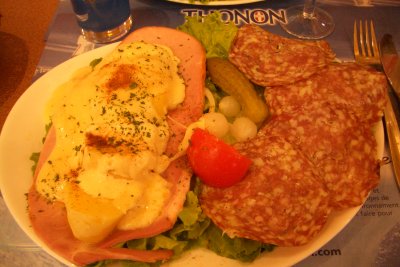 We reached the hotel about noon, left our baggage because the rooms weren't ready, and went out in search of lunch. After reading a few menus, we settled at l'Elysée, a brasserie less than a block away. I had an excellent omellette compagnard with potatoes, lardons, cheese, and crême fraiche and a little salad on the side. CJ got the vegetarian salad—greens topped with four large boiled potatoes and a cold mixture of braised vegetables (green beans, pepper, egg plant, etc.). David got the winner, though. He wanted a light lunch, so he just ordered a salad. His Salade Contoise turned out to be a platter-sized layer of lettuce and tomato entirely covered with a half-dozen six-inch-diameter slices of rosette (a sort of soft French salami) and a big slice of boiled ham. The ham was in turn covered by a good pound of sliced boiled potato, and that was covered by at least a half a pound of melted raclette cheese! Wow. It was delicious (I tried some, since he couldn't come near finishing it), and it was huge! CJ and I each had a coupe Jamaïque (rum raisin and coffee ice creams, coffee syrup, whipped cream, and a rolled cookie; almond sprinkles for me); David just had a coffee, which afterward he wasn't entirely sure had been decaf, but a couple of hours later, his eyes werent spinning in their sockets, so it must have been okay.
We reached the hotel about noon, left our baggage because the rooms weren't ready, and went out in search of lunch. After reading a few menus, we settled at l'Elysée, a brasserie less than a block away. I had an excellent omellette compagnard with potatoes, lardons, cheese, and crême fraiche and a little salad on the side. CJ got the vegetarian salad—greens topped with four large boiled potatoes and a cold mixture of braised vegetables (green beans, pepper, egg plant, etc.). David got the winner, though. He wanted a light lunch, so he just ordered a salad. His Salade Contoise turned out to be a platter-sized layer of lettuce and tomato entirely covered with a half-dozen six-inch-diameter slices of rosette (a sort of soft French salami) and a big slice of boiled ham. The ham was in turn covered by a good pound of sliced boiled potato, and that was covered by at least a half a pound of melted raclette cheese! Wow. It was delicious (I tried some, since he couldn't come near finishing it), and it was huge! CJ and I each had a coupe Jamaïque (rum raisin and coffee ice creams, coffee syrup, whipped cream, and a rolled cookie; almond sprinkles for me); David just had a coffee, which afterward he wasn't entirely sure had been decaf, but a couple of hours later, his eyes werent spinning in their sockets, so it must have been okay.
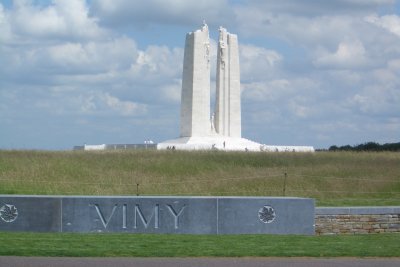 Once we were checked into our rooms, we headed back north the short distance to Vimy Ridge to visit the Canadian memorial, which is magnificent. The monument itself stands on "hill 145," the highest point on the ridge, facing north, toward the territory held by the Germans at the time the Canadians took the ridge from them. It's the only high ground for miles around and holding it permitted the Germans to protect the coal-mining and manufacturing operations north of it. The complex around it includes two Canadian war cemeteries, a small museum, and a section of ground in which tunnels, trenches, and shell holes are preserved. At the time of the battle, it was a wasteland of mud and shell holes, dotted with blasted tree stumps, without a blade of grass. Today, some areas are open and park-like, and the rest, still pitched and pocked with shell holes and old trenches, are covered in a sparse stand of large pines. The wooded areas are fenced off with three stands of electrified fencing, and large red bilingual signs warn that they have not been cleared of unexploded ordnance. Shaggy, long-tailed sheep graze on some of them.
Once we were checked into our rooms, we headed back north the short distance to Vimy Ridge to visit the Canadian memorial, which is magnificent. The monument itself stands on "hill 145," the highest point on the ridge, facing north, toward the territory held by the Germans at the time the Canadians took the ridge from them. It's the only high ground for miles around and holding it permitted the Germans to protect the coal-mining and manufacturing operations north of it. The complex around it includes two Canadian war cemeteries, a small museum, and a section of ground in which tunnels, trenches, and shell holes are preserved. At the time of the battle, it was a wasteland of mud and shell holes, dotted with blasted tree stumps, without a blade of grass. Today, some areas are open and park-like, and the rest, still pitched and pocked with shell holes and old trenches, are covered in a sparse stand of large pines. The wooded areas are fenced off with three stands of electrified fencing, and large red bilingual signs warn that they have not been cleared of unexploded ordnance. Shaggy, long-tailed sheep graze on some of them.
Written 21 June 2007
The big battle of Vimy Ridge was in April of 1917. At the outbreak of the war, Canada's army was very small, but as recruitment proceeded, more and more Canadian troops were sent to Europe piecemeal. Vimy was the first place where all four Canadian divisions came together and fought as a unit, and they were assigned the task of taking the ridge. They prepared for months, digging trenches, tunnels, and what Japrisot calls "boyaux" in Un Long Dimanche de Fiançailles. The word means pipe or hose, and I was never sure how it differed from "tunnel" until, on this tour, I learned that it was a small, narrow tunnel through which one had to crawl. Sappers dug them, in particular, in advance of the farthest-forward lines, to plant large mines deep under no-man's-land, which were set off on the day of the battle. This huge coordinated attack was actually commanded by Lieutenant-General Byng, of "Byng au Crepuscule" (= Bingo Crepuscule), which features so prominently in Japrisot's book (although the battles mentioned in the book were a long way from Vimy Ridge and didn't involve the Canadian forces).
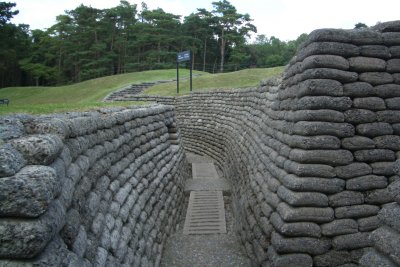 The lines on both sides were arranged in several layers: an advance set of trenches, very lightly manned and mainly for observation, a large set a few hundred yards back, much more heavily manned, and yet another set behind those, for reserves and supply. Tunnels and "boyaux" connected them. Vimy is one of the few places where part of this set-up has been preserved. The German and Canadian advance trenches were less than 100 meters apart! (David tells me that, in some places where the lines were so close together, only a single barbed-wire barrier separated them. Both sides wanted it there, so by tacit agreement, they took turns repairing and maintaining it.) At the time, of course, the advance trenches would have been a muddy mess. Today, they're lined with concrete "sandbags" and have hard floors. You can walk into side branches, step up on a little shelf designed for the purpose and peer across to the lines on the other side. Some are equipped with iron panels a couple of feet square, pierced by a single hole through which a spyglass or rifle could be extended while the iron protected your head.
The lines on both sides were arranged in several layers: an advance set of trenches, very lightly manned and mainly for observation, a large set a few hundred yards back, much more heavily manned, and yet another set behind those, for reserves and supply. Tunnels and "boyaux" connected them. Vimy is one of the few places where part of this set-up has been preserved. The German and Canadian advance trenches were less than 100 meters apart! (David tells me that, in some places where the lines were so close together, only a single barbed-wire barrier separated them. Both sides wanted it there, so by tacit agreement, they took turns repairing and maintaining it.) At the time, of course, the advance trenches would have been a muddy mess. Today, they're lined with concrete "sandbags" and have hard floors. You can walk into side branches, step up on a little shelf designed for the purpose and peer across to the lines on the other side. Some are equipped with iron panels a couple of feet square, pierced by a single hole through which a spyglass or rifle could be extended while the iron protected your head.
 We took the guided tour of the tunnel system. The guides are bilingual Canadian university students (ours, Paul, is a law student) who come over for four-month stints. Each tour is accompanied by two guides, one in front doing the talking and another at the rear keeping track of stragglers (and available, if need arises, to taken anyone struck by claustrophobia back to the surface by the shortest route). We were only five, and no one got upset, so the second guide was just along for the stroll. The tunnels, only slightly modified and reinforced (but much better lit) since 1917, run through chalk. During the Canadians' secret preparations, all the chalk they removed was carried back through the tunnels and hidden far to the rear; its white color would have been quite obvious if it were piled where the Germans could see it. A central tunnel was fitted with light, narrow-gauge rail so that the bags of soil could be piled on little wooden carts and pushed along it.
We took the guided tour of the tunnel system. The guides are bilingual Canadian university students (ours, Paul, is a law student) who come over for four-month stints. Each tour is accompanied by two guides, one in front doing the talking and another at the rear keeping track of stragglers (and available, if need arises, to taken anyone struck by claustrophobia back to the surface by the shortest route). We were only five, and no one got upset, so the second guide was just along for the stroll. The tunnels, only slightly modified and reinforced (but much better lit) since 1917, run through chalk. During the Canadians' secret preparations, all the chalk they removed was carried back through the tunnels and hidden far to the rear; its white color would have been quite obvious if it were piled where the Germans could see it. A central tunnel was fitted with light, narrow-gauge rail so that the bags of soil could be piled on little wooden carts and pushed along it.
The tunnels are high enough to walk through and just wide enough for two people to pass one another. Most of them are about about 10 m below the surface (though the sappers dug down to bury mines as deep as 30 m). We visited the little cluster of rooms that served as headquarters for a lieutenant colonel and his staff: a communications room with both telephones and a dormitory for 8-12 staff runners, a command post with adjacent office/bedroom for the lt. col., the officers' mess. At the end of one tunnel, at only 5 m depth, an unexploded shell is visible protruding from the wall, still in place where the tunnellers found it.
The Canadian artillery pounded the German lines for weeks in advance, but only with half their 350 guns. During the last week of preparations, they used all the guns and lobbed a million shells—the Germans called it "the week of suffering." The night before the attack, they moved thousands of men forward through the tunnels. Thousands more crept up behind on the surface. On the morning of the attack, they set off the mines under no-man's-land to throw up impromptu breastworks, and men poured out of tunnels dug far forward for the purpose. The rest came up the hill behind them. Casualties were appalling (11,000+ out of 60,000, not actually all that high for WWI), but they took the ridge exactly as planned.

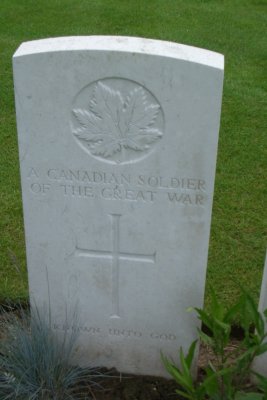 The grave markers in the cemeteries are more personalized than those in the others we visited. They're uniform in size, shape, and color (round-topped stone tablets), but some include short personalized quotations or epitaphs, usually below a carved cross but sometimes in place of it. They don't give town or province of origin, but on one grave, we found a small tablet dated 2001 that was a tribute from a secondary school graduating class in Alberta, presumably from the soldier's home town.
The grave markers in the cemeteries are more personalized than those in the others we visited. They're uniform in size, shape, and color (round-topped stone tablets), but some include short personalized quotations or epitaphs, usually below a carved cross but sometimes in place of it. They don't give town or province of origin, but on one grave, we found a small tablet dated 2001 that was a tribute from a secondary school graduating class in Alberta, presumably from the soldier's home town.
The monument itself consists of two 30-m pylons, representing France and Canada, and about 20 monumental carved figures representing France, Canada, Peace, Virtue, etc. By coincidence, we came at just the right time. It's been entirely covered for two years for a major restoration, and this is its first year in its new, pristine glory. Around the base are carved all the names of the many thousands whose graves are unknown. I found no Thistles (David tells me they would be with the Newfoundland regiments, memorialized elsewhere because they were not part of Canada at the time), but the list included an H. E. Burnham and an "A. W. Bonnyman served as A. W. Burnham."
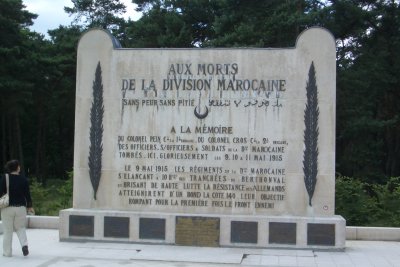 Across the road from it stands a much smaller monument to a Moroccan regiment, described as "the first to break the German lines" and the only one ever to have its flag decorated with the Legion of Honor.
Across the road from it stands a much smaller monument to a Moroccan regiment, described as "the first to break the German lines" and the only one ever to have its flag decorated with the Legion of Honor.
Dinner last night was at Le Clusius, the restaurant of the Hotel l'Univers. We tried to stay there, but it was booked up, even in March. We realized only after arriving yesterday that the 20th annual French Women's Open golf tournament is in progress on the local course, so accommodations are tighter than usual.
For once, the menu we chose included no fish or nuts, so no special negotiations were necessary.
First amuse-bouche: Miniature "briks" (crisp pastry triangles) of mussels, tiny puff pastry shells filled with ham mousse.
Second amuse-bouche: A bright pink jellied ham salad drizzled with oil flavored with piments d'Espelette and a streak of balsamic reduction; garnished with a mâche leaf and a sprig of lavender.
First course: Warm sautéed foie gras garnished with currants, sliced mango, a carved cherry tomato, and more lavender.
Second course: Roasted langoustine tails surrounding a small salad (which included batons of lightly cooked vegetables and whole basil leaves) and topped with a thin slice of raw ham toasted crisp in the oven.
Palate cleanser: Vibrant lime sorbet.
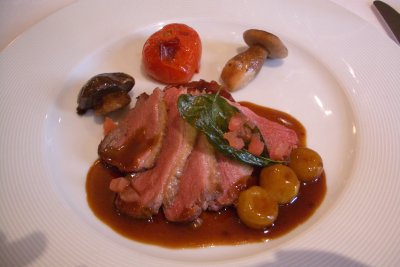 Third course: Rare roasted duck breast with whole, fresh "cêpe" mushrooms (Boletus sp., probably B. edulis, called "porcini" in Italian; delicious!); a roasted tomato; a miniature tarte tatin (upside-down apple tart); three peeled, poached grapes; a fried basil leaf filled with diced fresh tomato; and a delicious, slightly sweet brown sauce.
Third course: Rare roasted duck breast with whole, fresh "cêpe" mushrooms (Boletus sp., probably B. edulis, called "porcini" in Italian; delicious!); a roasted tomato; a miniature tarte tatin (upside-down apple tart); three peeled, poached grapes; a fried basil leaf filled with diced fresh tomato; and a delicious, slightly sweet brown sauce.
Cheese: CJ had her usual favorites, reblochon and camembert. David had bleu d'Auvergne, comté, and "vieux gris de Lille." I had Valençay, crottin de Chavignol, and the vieux gris. We'd never seen the vieux gris before and both wanted to see what it was like. I don't think I'd order it again.
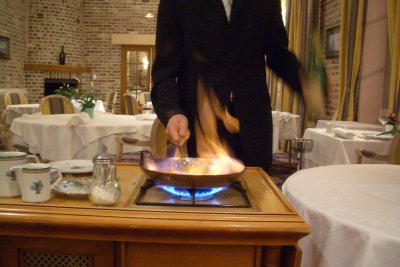 Dessert: David had a little round chestnut cake with chestnut filling and vanilla sauce. I had a "vacherin" (crisp meringue cake) with vanilla ice cream and sorbet of "griottes" (sour morello cherries) with dark cherry jam (excellent). CJ ordered the crêpes flambées, which were spectacularly flamed at tableside and served with intense tangerine sorbet and candied citrus peel.
Dessert: David had a little round chestnut cake with chestnut filling and vanilla sauce. I had a "vacherin" (crisp meringue cake) with vanilla ice cream and sorbet of "griottes" (sour morello cherries) with dark cherry jam (excellent). CJ ordered the crêpes flambées, which were spectacularly flamed at tableside and served with intense tangerine sorbet and candied citrus peel.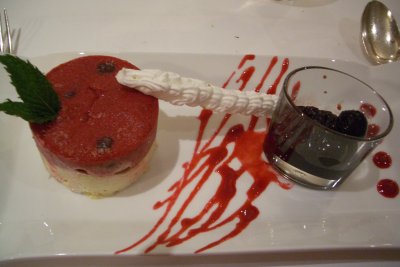
previous entry
List of Entries
next entry
 We reached the hotel about noon, left our baggage because the rooms weren't ready, and went out in search of lunch. After reading a few menus, we settled at l'Elysée, a brasserie less than a block away. I had an excellent omellette compagnard with potatoes, lardons, cheese, and crême fraiche and a little salad on the side. CJ got the vegetarian salad—greens topped with four large boiled potatoes and a cold mixture of braised vegetables (green beans, pepper, egg plant, etc.). David got the winner, though. He wanted a light lunch, so he just ordered a salad. His Salade Contoise turned out to be a platter-sized layer of lettuce and tomato entirely covered with a half-dozen six-inch-diameter slices of rosette (a sort of soft French salami) and a big slice of boiled ham. The ham was in turn covered by a good pound of sliced boiled potato, and that was covered by at least a half a pound of melted raclette cheese! Wow. It was delicious (I tried some, since he couldn't come near finishing it), and it was huge! CJ and I each had a coupe Jamaïque (rum raisin and coffee ice creams, coffee syrup, whipped cream, and a rolled cookie; almond sprinkles for me); David just had a coffee, which afterward he wasn't entirely sure had been decaf, but a couple of hours later, his eyes werent spinning in their sockets, so it must have been okay.
We reached the hotel about noon, left our baggage because the rooms weren't ready, and went out in search of lunch. After reading a few menus, we settled at l'Elysée, a brasserie less than a block away. I had an excellent omellette compagnard with potatoes, lardons, cheese, and crême fraiche and a little salad on the side. CJ got the vegetarian salad—greens topped with four large boiled potatoes and a cold mixture of braised vegetables (green beans, pepper, egg plant, etc.). David got the winner, though. He wanted a light lunch, so he just ordered a salad. His Salade Contoise turned out to be a platter-sized layer of lettuce and tomato entirely covered with a half-dozen six-inch-diameter slices of rosette (a sort of soft French salami) and a big slice of boiled ham. The ham was in turn covered by a good pound of sliced boiled potato, and that was covered by at least a half a pound of melted raclette cheese! Wow. It was delicious (I tried some, since he couldn't come near finishing it), and it was huge! CJ and I each had a coupe Jamaïque (rum raisin and coffee ice creams, coffee syrup, whipped cream, and a rolled cookie; almond sprinkles for me); David just had a coffee, which afterward he wasn't entirely sure had been decaf, but a couple of hours later, his eyes werent spinning in their sockets, so it must have been okay. Once we were checked into our rooms, we headed back north the short distance to Vimy Ridge to visit the Canadian memorial, which is magnificent. The monument itself stands on "hill 145," the highest point on the ridge, facing north, toward the territory held by the Germans at the time the Canadians took the ridge from them. It's the only high ground for miles around and holding it permitted the Germans to protect the coal-mining and manufacturing operations north of it. The complex around it includes two Canadian war cemeteries, a small museum, and a section of ground in which tunnels, trenches, and shell holes are preserved. At the time of the battle, it was a wasteland of mud and shell holes, dotted with blasted tree stumps, without a blade of grass. Today, some areas are open and park-like, and the rest, still pitched and pocked with shell holes and old trenches, are covered in a sparse stand of large pines. The wooded areas are fenced off with three stands of electrified fencing, and large red bilingual signs warn that they have not been cleared of unexploded ordnance. Shaggy, long-tailed sheep graze on some of them.
Once we were checked into our rooms, we headed back north the short distance to Vimy Ridge to visit the Canadian memorial, which is magnificent. The monument itself stands on "hill 145," the highest point on the ridge, facing north, toward the territory held by the Germans at the time the Canadians took the ridge from them. It's the only high ground for miles around and holding it permitted the Germans to protect the coal-mining and manufacturing operations north of it. The complex around it includes two Canadian war cemeteries, a small museum, and a section of ground in which tunnels, trenches, and shell holes are preserved. At the time of the battle, it was a wasteland of mud and shell holes, dotted with blasted tree stumps, without a blade of grass. Today, some areas are open and park-like, and the rest, still pitched and pocked with shell holes and old trenches, are covered in a sparse stand of large pines. The wooded areas are fenced off with three stands of electrified fencing, and large red bilingual signs warn that they have not been cleared of unexploded ordnance. Shaggy, long-tailed sheep graze on some of them. The lines on both sides were arranged in several layers: an advance set of trenches, very lightly manned and mainly for observation, a large set a few hundred yards back, much more heavily manned, and yet another set behind those, for reserves and supply. Tunnels and "boyaux" connected them. Vimy is one of the few places where part of this set-up has been preserved. The German and Canadian advance trenches were less than 100 meters apart! (David tells me that, in some places where the lines were so close together, only a single barbed-wire barrier separated them. Both sides wanted it there, so by tacit agreement, they took turns repairing and maintaining it.) At the time, of course, the advance trenches would have been a muddy mess. Today, they're lined with concrete "sandbags" and have hard floors. You can walk into side branches, step up on a little shelf designed for the purpose and peer across to the lines on the other side. Some are equipped with iron panels a couple of feet square, pierced by a single hole through which a spyglass or rifle could be extended while the iron protected your head.
The lines on both sides were arranged in several layers: an advance set of trenches, very lightly manned and mainly for observation, a large set a few hundred yards back, much more heavily manned, and yet another set behind those, for reserves and supply. Tunnels and "boyaux" connected them. Vimy is one of the few places where part of this set-up has been preserved. The German and Canadian advance trenches were less than 100 meters apart! (David tells me that, in some places where the lines were so close together, only a single barbed-wire barrier separated them. Both sides wanted it there, so by tacit agreement, they took turns repairing and maintaining it.) At the time, of course, the advance trenches would have been a muddy mess. Today, they're lined with concrete "sandbags" and have hard floors. You can walk into side branches, step up on a little shelf designed for the purpose and peer across to the lines on the other side. Some are equipped with iron panels a couple of feet square, pierced by a single hole through which a spyglass or rifle could be extended while the iron protected your head. We took the guided tour of the tunnel system. The guides are bilingual Canadian university students (ours, Paul, is a law student) who come over for four-month stints. Each tour is accompanied by two guides, one in front doing the talking and another at the rear keeping track of stragglers (and available, if need arises, to taken anyone struck by claustrophobia back to the surface by the shortest route). We were only five, and no one got upset, so the second guide was just along for the stroll. The tunnels, only slightly modified and reinforced (but much better lit) since 1917, run through chalk. During the Canadians' secret preparations, all the chalk they removed was carried back through the tunnels and hidden far to the rear; its white color would have been quite obvious if it were piled where the Germans could see it. A central tunnel was fitted with light, narrow-gauge rail so that the bags of soil could be piled on little wooden carts and pushed along it.
We took the guided tour of the tunnel system. The guides are bilingual Canadian university students (ours, Paul, is a law student) who come over for four-month stints. Each tour is accompanied by two guides, one in front doing the talking and another at the rear keeping track of stragglers (and available, if need arises, to taken anyone struck by claustrophobia back to the surface by the shortest route). We were only five, and no one got upset, so the second guide was just along for the stroll. The tunnels, only slightly modified and reinforced (but much better lit) since 1917, run through chalk. During the Canadians' secret preparations, all the chalk they removed was carried back through the tunnels and hidden far to the rear; its white color would have been quite obvious if it were piled where the Germans could see it. A central tunnel was fitted with light, narrow-gauge rail so that the bags of soil could be piled on little wooden carts and pushed along it.
 The grave markers in the cemeteries are more personalized than those in the others we visited. They're uniform in size, shape, and color (round-topped stone tablets), but some include short personalized quotations or epitaphs, usually below a carved cross but sometimes in place of it. They don't give town or province of origin, but on one grave, we found a small tablet dated 2001 that was a tribute from a secondary school graduating class in Alberta, presumably from the soldier's home town.
The grave markers in the cemeteries are more personalized than those in the others we visited. They're uniform in size, shape, and color (round-topped stone tablets), but some include short personalized quotations or epitaphs, usually below a carved cross but sometimes in place of it. They don't give town or province of origin, but on one grave, we found a small tablet dated 2001 that was a tribute from a secondary school graduating class in Alberta, presumably from the soldier's home town. Across the road from it stands a much smaller monument to a Moroccan regiment, described as "the first to break the German lines" and the only one ever to have its flag decorated with the Legion of Honor.
Across the road from it stands a much smaller monument to a Moroccan regiment, described as "the first to break the German lines" and the only one ever to have its flag decorated with the Legion of Honor. Third course: Rare roasted duck breast with whole, fresh "cêpe" mushrooms (Boletus sp., probably B. edulis, called "porcini" in Italian; delicious!); a roasted tomato; a miniature tarte tatin (upside-down apple tart); three peeled, poached grapes; a fried basil leaf filled with diced fresh tomato; and a delicious, slightly sweet brown sauce.
Third course: Rare roasted duck breast with whole, fresh "cêpe" mushrooms (Boletus sp., probably B. edulis, called "porcini" in Italian; delicious!); a roasted tomato; a miniature tarte tatin (upside-down apple tart); three peeled, poached grapes; a fried basil leaf filled with diced fresh tomato; and a delicious, slightly sweet brown sauce. Dessert: David had a little round chestnut cake with chestnut filling and vanilla sauce. I had a "vacherin" (crisp meringue cake) with vanilla ice cream and sorbet of "griottes" (sour morello cherries) with dark cherry jam (excellent). CJ ordered the crêpes flambées, which were spectacularly flamed at tableside and served with intense tangerine sorbet and candied citrus peel.
Dessert: David had a little round chestnut cake with chestnut filling and vanilla sauce. I had a "vacherin" (crisp meringue cake) with vanilla ice cream and sorbet of "griottes" (sour morello cherries) with dark cherry jam (excellent). CJ ordered the crêpes flambées, which were spectacularly flamed at tableside and served with intense tangerine sorbet and candied citrus peel.